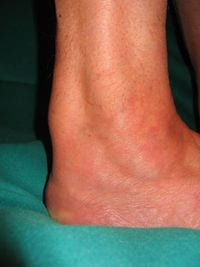Acute Achillodynia (Paratendinitis)
The reasons for acute pain and Achilles tendon irritation are anatomic: The Achilles tendon is surrounded by a thin layer of tissue and glides by moving in a type of tube (tendon sheath) consisting of six to eight membranes. To protect against friction, there are gelatinous connections, mucopolysaccharides, between the layers of tissue. The resilience of the tendon depends on the consistency of the mucopolysaccharides: the more the membranes are able to glide, the lower the risk of injury.

The Achilles tendon bends the ankle, pulling the forefoot downwards with force. This movement is crucial for pushing off the foot when walking and running and is performed many hundreds of times during a normal training run, bearing several times a person’s body weight. When overexerted, the consistency of the mucopolysaccharides changes and pain commences (one is therefore more susceptible to Achilles issues in winter, as low temperatures cause the consistency of the lubricating substance to become markedly more viscous).
Typical symptoms include pain, swelling,‚ and overheating of the Achilles tendon. A runner often feels an uncomfortable pulling sensation in the area of the tendon, as well as severe tenderness in the affected region. The tendon and the surrounding tissue can swell and the thickening is often palpable and hot to the touch. For keen runners, the day often begins with a feeling of frustration, as pain is usually particularly severe in the mornings. Even when running, the first few minutes are especially uncomfortable, after which the pain often disappears and only a pulling sensation is felt. More severe pain then reoccurs after running and at night.
More questions?
Our experts are happy to help you
Just give us a call!




